What are dry eyes?
Tears keep the corneal surface moist and lubricated. They are produced by the tear glands and reach the eye surface through the tear ducts. A decrease in the production of tears or increased evaporation leads to a condition called dry eyes.

What causes dry eyes?
Normally tears form a continuous film on the corneal surface. Less tears resulting from increased evaporation or decreased production causes instability of the tear film which leads to dry patches on the corneal surface. Moreover, tears are mostly made up of water and salts. Decreased tear production and increased evaporation increases the salt content of the tears i.e. their osmolality, which further pulls water from the corneal surface. This causes discomfort and abrasion on the surface of the cornea further leading to inflammation.
Decreased tear production can occur due to:
- Sjogren’s syndrome: This is an autoimmune disease where antibodies are made by the body against its various tissues. Inflammation can occur in the tear glands and salivary glands leading to decreased secretion from these glands resulting in symptoms of dry eyes and dry mouth (primary Sjogren’s syndrome). Sjogren’s syndrome may occur with other autoimmune diseases such as rheumatoid arthritis, systemic lupus erythematosus, scleroderma, polymyositis (secondary Sjogren’s syndrome).
- Other factors that lead to reduced production of tears include sarcoidosis, vitamin A deficiency, trachoma, trauma, previous eye surgery involving corneal incision, long term contact lens wear, working on a computer for long hours, past herpes infection, diabetes and aging.
Increased evaporation of tears can occur due to:
- Environmental factors such as dry weather, wind, air pollution, hair dryer use, air-conditioned environments
- Inflammation of the eyelid as in cases of blepharitis, rosacea and Meibomian gland dysfunction
- Certain medicines such as birth control pills and allergy medications
- Thyroid disorder that can result in retraction of the upper eye lid
What are the symptoms of dry eyes?
Patients suffering from dry eyes usually complain of:
- A stinging, burning or scratching sensation
- Discomfort in wearing lenses
- Eye irritation in air-conditioned places and in wind
- Tired eyes
- Redness
- Blurring of vision
- Discomfort from glaring light
- Increased tear production due to eye irritation
How are dry eyes diagnosed?
Although dry eyes can be diagnosed based on the symptoms, your doctor may perform certain simple tests to assess your condition.
- Schirmer’s eye test: A very small filter paper strip is placed touching the lower eye lid for a specific time. A wetting value of less than 5mm of the filter paper strip in 5 minutes indicates dry eyes.
- Phenol red thread test: This test uses a cotton thread coated with phenol red dye. It is kept for 15 seconds in the lower conjunctival fornix. A wetting length of 9- 20mm is considered normal while less than 9mm wetting length suggests dry eyes.
- Tear break up time: A strip of fluorescein will be applied to the lower eyelid and removed. Then, you will be told to blink your eyes three times and look forward without blinking. The tear film formed is observed under a slit lamp microscope and the breakup time of the film is recorded. A break up time of 10 seconds or less indicates dry eyes.
- Another more accurate and patient friendly test measures tear break up time using a tearscope. In this test, values of less than 15 seconds indicate dry eyes.


 n
n